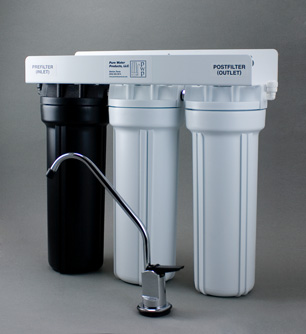Replacing UV Lamps and Cleaning Quartz Sleeves in Residential Units
Ultraviolet (UV) water treatment is overall the most trouble-free method for providing safe, microbe free residential water. Compared with chlorination, modern UV units require no mixing of chemicals and pump maintenance and, in general, far less attention. They do, however, require in most cases an annual lamp change and periodic inspection and cleaning, if needed, of the quartz tube that protects the lamp.
Lamp Changes
UV lamps lose 40% of their intensity in 9000 hours, roughly one year of continuous use.
Ultraviolet light is not visible to the naked eye, and the UV lamp will still be glowing after a year’s worth of use. The glow that you see, however, is not in the UV spectrum and the UV intensity will not be high enough to provide proper dosage for disinfection.UV lamps are manufactured with the assumption that the UV intensity will fall to 60% of original levels at the end of one year. They are designed oversized to provide rated dosage and hence safe and effective disinfection at the end of the stated lamp life, which is usually one year. When a new lamp is installed, it is providing dosage higher than necessary, and it falls gradually to rated dosage at the end of one year. This is the reason it is highly recommended you keep accurate records of when lamps are replaced and replace them annually. Some vendors keep lamp purchase records and remind their customers.
Keeping the Quartz Sleeve Clean
For the UV unit to work properly, UV rays must pass through the quartz tube (usually called a quartz sleeve) into the water. With frequency depending on the nature of the water, the sleeve needs periodic cleaning. Debris deposits formed on the quartz sleeves will block the UV rays and reduce the effectiveness of the treatment.
How often should the quartz sleeve be cleaned? To a great extent, the frequency of cleaning will depend upon the water quality. The more minerals present in the water, the more frequently the sleeve will require cleaning. An initial visual inspection of the quartz sleeve should be done when the unit has been in service for about a month. This inspection will provide a clue for determining how often the sleeve needs to be cleaned.
If the sleeve is very dirty, monthly cleaning may be needed. If it remains very clean after 30 days (which should be the case if the water has been properly pretreated), examining and cleaning the sleeve annually when the lamp is changed will be enough.
Cleaning the sleeve is best done by removing it from the UV unit and washing it with warm soapy water. Rinse thoroughly. If this is not sufficient, denatured alcohol will usually do the trick. Avoid scratching the tube, and when reinstalling wear cloth gloves to avoid spotting the sleeve with oil from your hands.




![wattsuv450vertical[1]](http://purewatergazette.net/blog/wp-content/uploads/2013/05/wattsuv450vertical1.jpg)


![tees[1]](http://purewatergazette.net/blog/wp-content/uploads/2013/05/tees1.jpg)

![jg_murlock[1]](http://purewatergazette.net/blog/wp-content/uploads/2013/05/jg_murlock1.jpg)

![usmctaintedwater_3[1]](http://purewatergazette.net/blog/wp-content/uploads/2012/09/usmctaintedwater_31.jpg)

![the_truck_770[1]](http://purewatergazette.net/blog/wp-content/uploads/2013/05/the_truck_7701-300x165.jpg)

![BottledWater-per-capita-2012-300x216[1]](http://purewatergazette.net/blog/wp-content/uploads/2013/04/BottledWater-per-capita-2012-300x2161.jpg)

